Development of Drugs and Medical Devices: A Comparative Analysis
VerifiedAdded on 2021/04/17
|11
|2133
|31
Report
AI Summary
This report provides a comparative analysis of the development processes for medical devices and drugs. It begins by defining medical devices and outlining their lifecycle, including research, design and development, FDA review, manufacturing, and obsolescence. The report then details the five stages of medical device development: discovery, preclinical research, clinical research, regulatory reviews, and post-marketing surveillance. Following this, the drug development process is explored, covering discovery and development, preclinical and clinical phases, the investigational new drug process, FDA review, and postmarket drug safety regulations. The report highlights the similarities and differences between the two development pathways, emphasizing that while both share similar stages, they differ in terms of the nature of the products (hardware vs. therapeutic), their effects on the body, and regulatory considerations. The report concludes by summarizing the key findings and emphasizing the importance of understanding these processes for healthcare professionals and researchers.
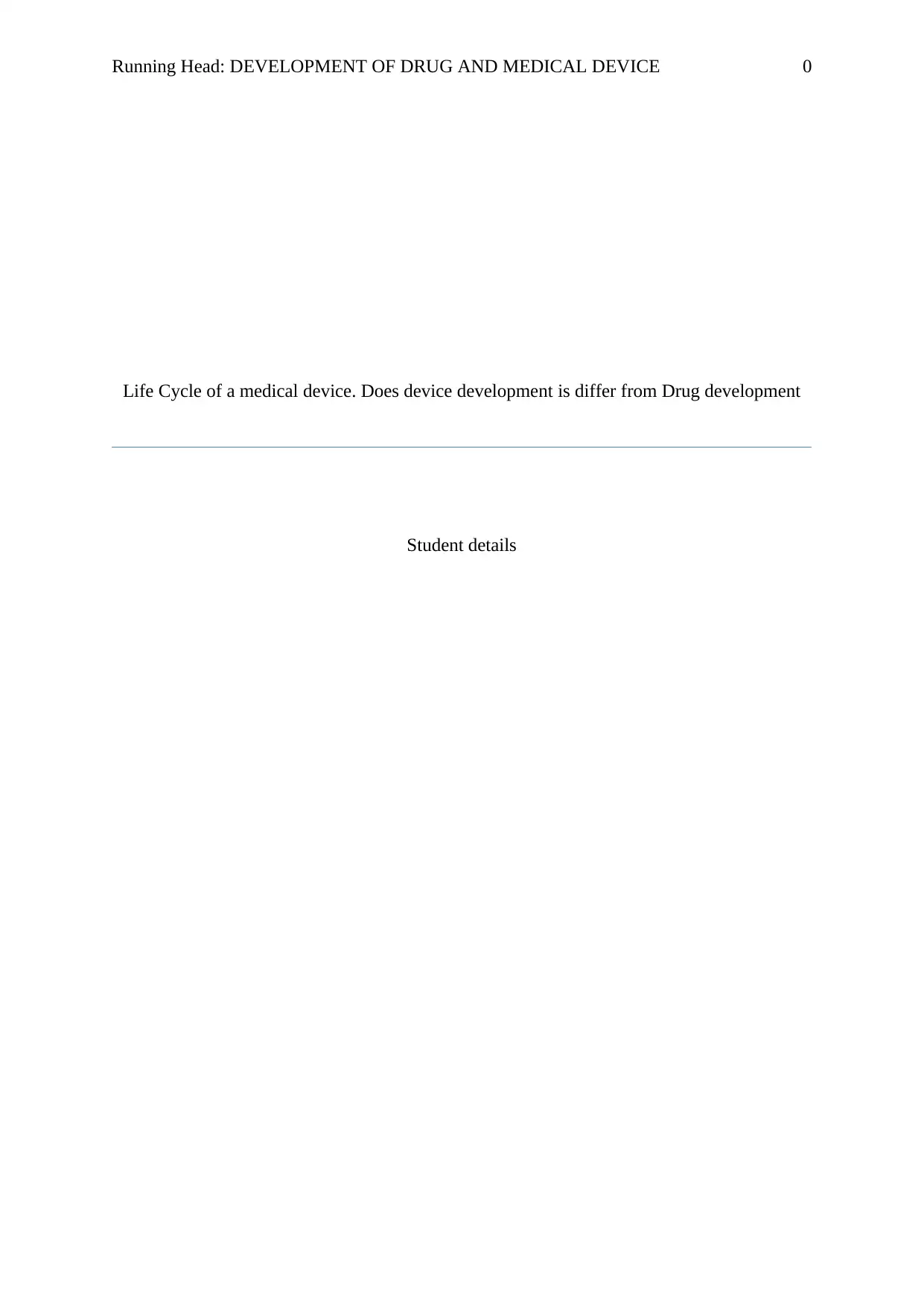
Running Head: DEVELOPMENT OF DRUG AND MEDICAL DEVICE 0
Life Cycle of a medical device. Does device development is differ from Drug development
Student details
Life Cycle of a medical device. Does device development is differ from Drug development
Student details
Paraphrase This Document
Need a fresh take? Get an instant paraphrase of this document with our AI Paraphraser
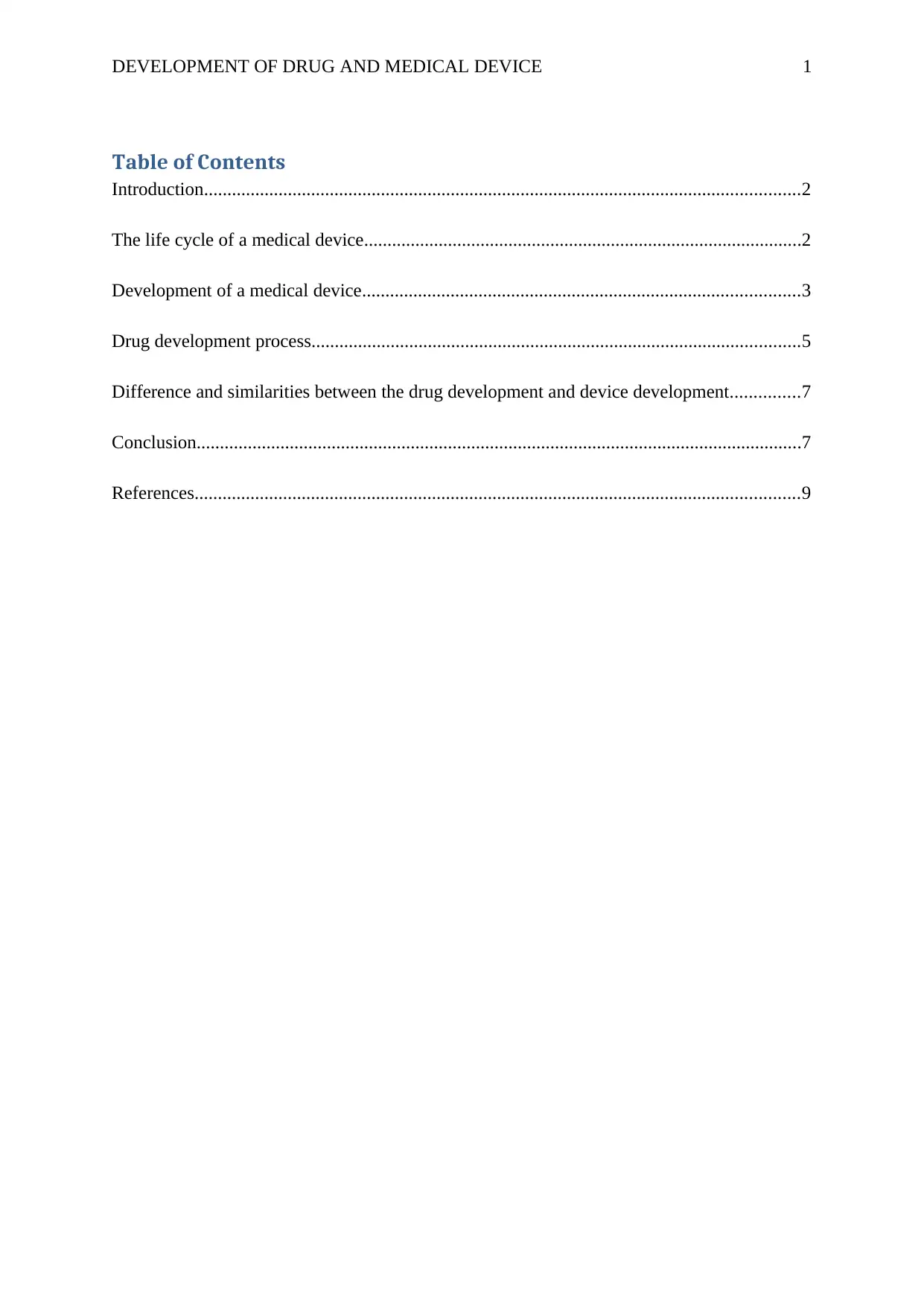
DEVELOPMENT OF DRUG AND MEDICAL DEVICE 1
Table of Contents
Introduction................................................................................................................................2
The life cycle of a medical device..............................................................................................2
Development of a medical device..............................................................................................3
Drug development process.........................................................................................................5
Difference and similarities between the drug development and device development...............7
Conclusion..................................................................................................................................7
References..................................................................................................................................9
Table of Contents
Introduction................................................................................................................................2
The life cycle of a medical device..............................................................................................2
Development of a medical device..............................................................................................3
Drug development process.........................................................................................................5
Difference and similarities between the drug development and device development...............7
Conclusion..................................................................................................................................7
References..................................................................................................................................9
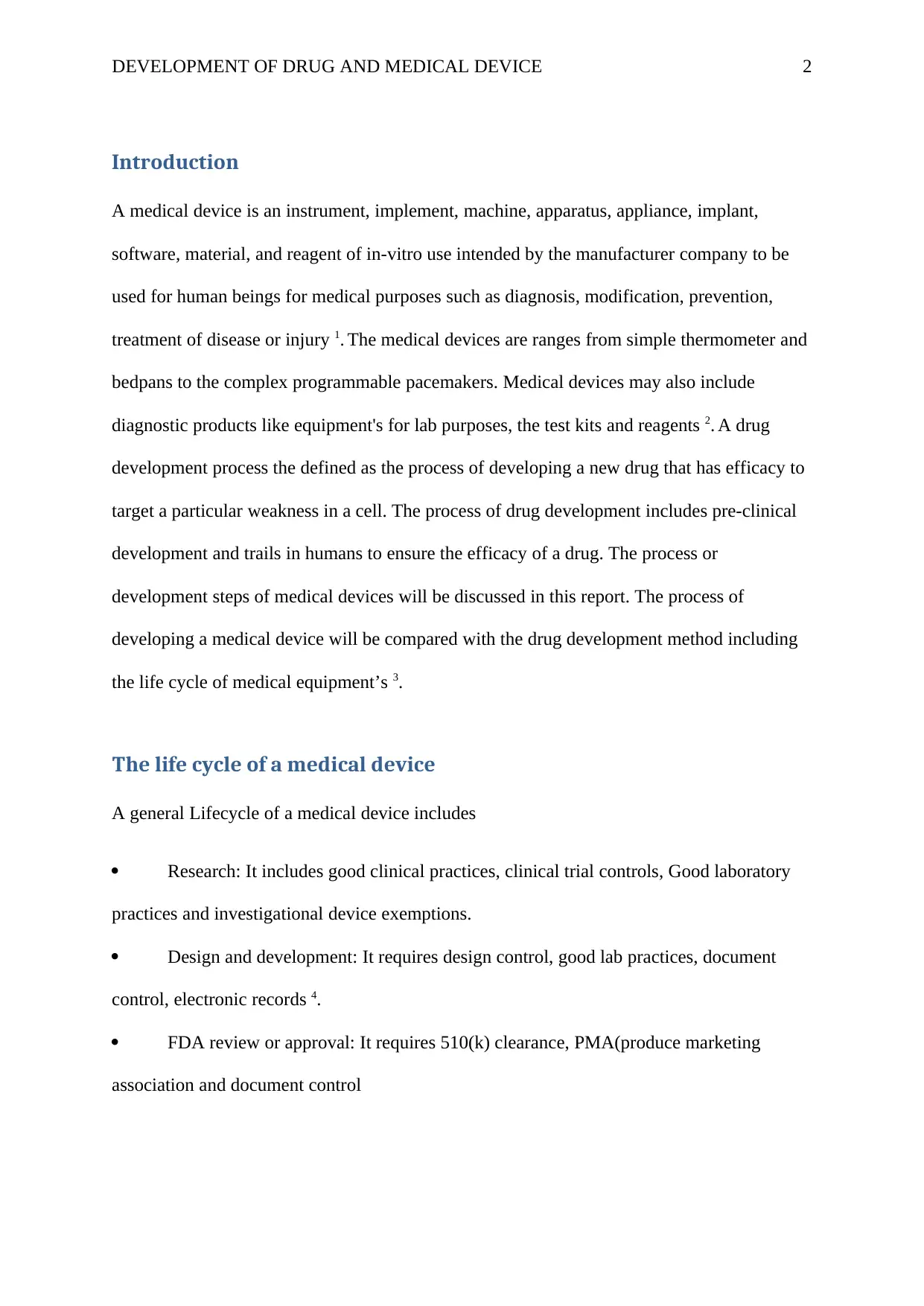
DEVELOPMENT OF DRUG AND MEDICAL DEVICE 2
Introduction
A medical device is an instrument, implement, machine, apparatus, appliance, implant,
software, material, and reagent of in-vitro use intended by the manufacturer company to be
used for human beings for medical purposes such as diagnosis, modification, prevention,
treatment of disease or injury 1. The medical devices are ranges from simple thermometer and
bedpans to the complex programmable pacemakers. Medical devices may also include
diagnostic products like equipment's for lab purposes, the test kits and reagents 2. A drug
development process the defined as the process of developing a new drug that has efficacy to
target a particular weakness in a cell. The process of drug development includes pre-clinical
development and trails in humans to ensure the efficacy of a drug. The process or
development steps of medical devices will be discussed in this report. The process of
developing a medical device will be compared with the drug development method including
the life cycle of medical equipment’s 3.
The life cycle of a medical device
A general Lifecycle of a medical device includes
Research: It includes good clinical practices, clinical trial controls, Good laboratory
practices and investigational device exemptions.
Design and development: It requires design control, good lab practices, document
control, electronic records 4.
FDA review or approval: It requires 510(k) clearance, PMA(produce marketing
association and document control
Introduction
A medical device is an instrument, implement, machine, apparatus, appliance, implant,
software, material, and reagent of in-vitro use intended by the manufacturer company to be
used for human beings for medical purposes such as diagnosis, modification, prevention,
treatment of disease or injury 1. The medical devices are ranges from simple thermometer and
bedpans to the complex programmable pacemakers. Medical devices may also include
diagnostic products like equipment's for lab purposes, the test kits and reagents 2. A drug
development process the defined as the process of developing a new drug that has efficacy to
target a particular weakness in a cell. The process of drug development includes pre-clinical
development and trails in humans to ensure the efficacy of a drug. The process or
development steps of medical devices will be discussed in this report. The process of
developing a medical device will be compared with the drug development method including
the life cycle of medical equipment’s 3.
The life cycle of a medical device
A general Lifecycle of a medical device includes
Research: It includes good clinical practices, clinical trial controls, Good laboratory
practices and investigational device exemptions.
Design and development: It requires design control, good lab practices, document
control, electronic records 4.
FDA review or approval: It requires 510(k) clearance, PMA(produce marketing
association and document control
⊘ This is a preview!⊘
Do you want full access?
Subscribe today to unlock all pages.

Trusted by 1+ million students worldwide
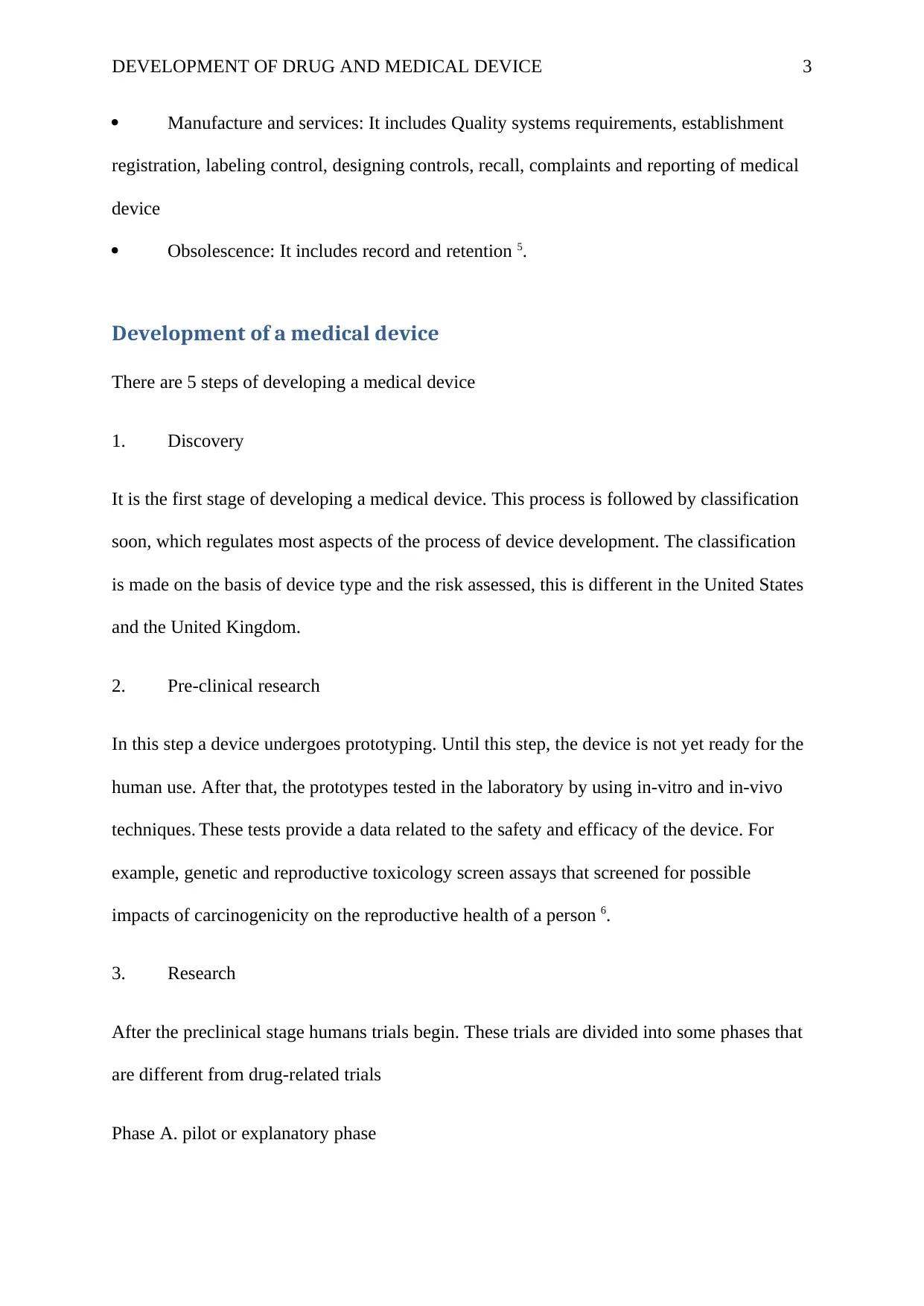
DEVELOPMENT OF DRUG AND MEDICAL DEVICE 3
Manufacture and services: It includes Quality systems requirements, establishment
registration, labeling control, designing controls, recall, complaints and reporting of medical
device
Obsolescence: It includes record and retention 5.
Development of a medical device
There are 5 steps of developing a medical device
1. Discovery
It is the first stage of developing a medical device. This process is followed by classification
soon, which regulates most aspects of the process of device development. The classification
is made on the basis of device type and the risk assessed, this is different in the United States
and the United Kingdom.
2. Pre-clinical research
In this step a device undergoes prototyping. Until this step, the device is not yet ready for the
human use. After that, the prototypes tested in the laboratory by using in-vitro and in-vivo
techniques. These tests provide a data related to the safety and efficacy of the device. For
example, genetic and reproductive toxicology screen assays that screened for possible
impacts of carcinogenicity on the reproductive health of a person 6.
3. Research
After the preclinical stage humans trials begin. These trials are divided into some phases that
are different from drug-related trials
Phase A. pilot or explanatory phase
Manufacture and services: It includes Quality systems requirements, establishment
registration, labeling control, designing controls, recall, complaints and reporting of medical
device
Obsolescence: It includes record and retention 5.
Development of a medical device
There are 5 steps of developing a medical device
1. Discovery
It is the first stage of developing a medical device. This process is followed by classification
soon, which regulates most aspects of the process of device development. The classification
is made on the basis of device type and the risk assessed, this is different in the United States
and the United Kingdom.
2. Pre-clinical research
In this step a device undergoes prototyping. Until this step, the device is not yet ready for the
human use. After that, the prototypes tested in the laboratory by using in-vitro and in-vivo
techniques. These tests provide a data related to the safety and efficacy of the device. For
example, genetic and reproductive toxicology screen assays that screened for possible
impacts of carcinogenicity on the reproductive health of a person 6.
3. Research
After the preclinical stage humans trials begin. These trials are divided into some phases that
are different from drug-related trials
Phase A. pilot or explanatory phase
Paraphrase This Document
Need a fresh take? Get an instant paraphrase of this document with our AI Paraphraser
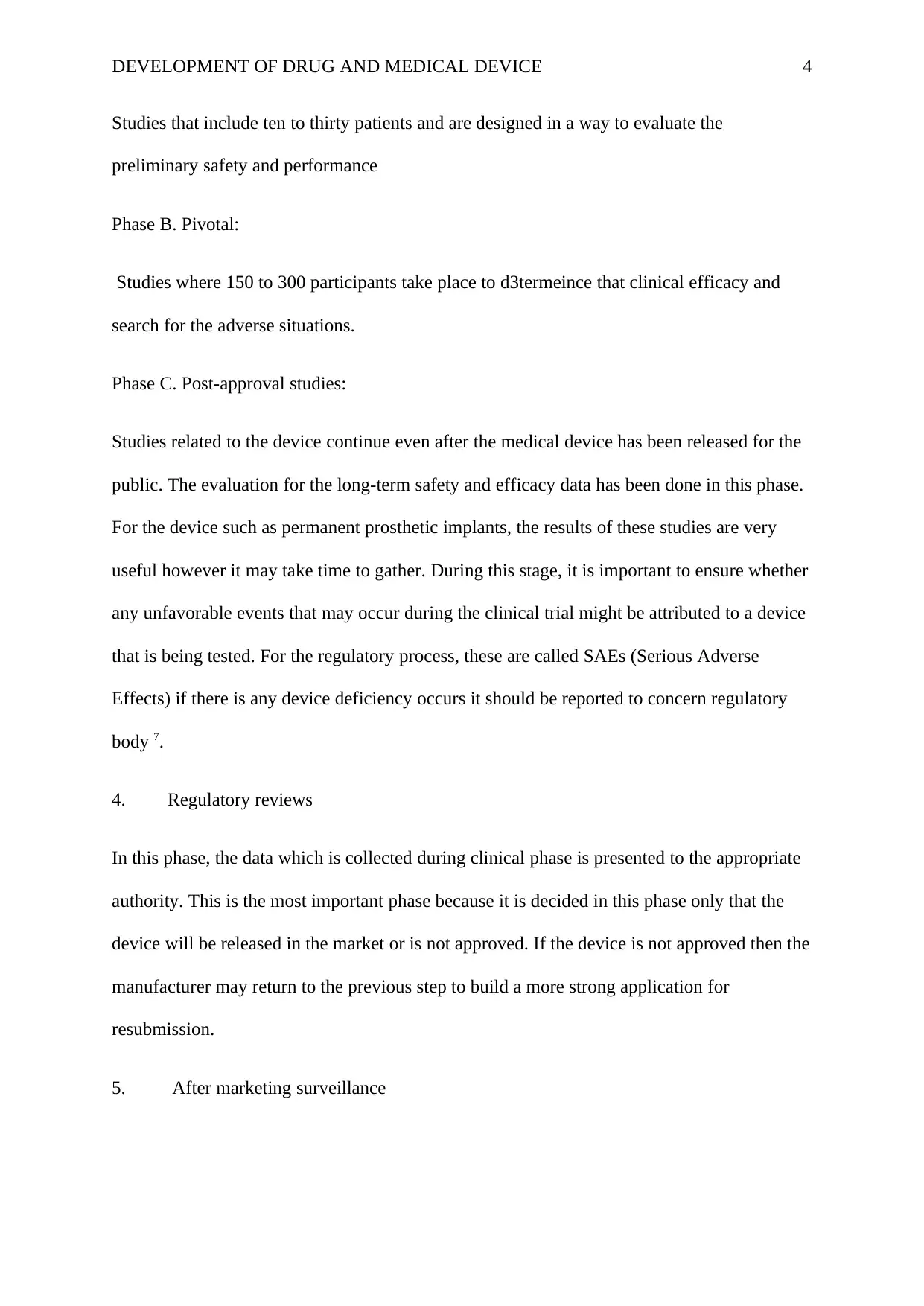
DEVELOPMENT OF DRUG AND MEDICAL DEVICE 4
Studies that include ten to thirty patients and are designed in a way to evaluate the
preliminary safety and performance
Phase B. Pivotal:
Studies where 150 to 300 participants take place to d3termeince that clinical efficacy and
search for the adverse situations.
Phase C. Post-approval studies:
Studies related to the device continue even after the medical device has been released for the
public. The evaluation for the long-term safety and efficacy data has been done in this phase.
For the device such as permanent prosthetic implants, the results of these studies are very
useful however it may take time to gather. During this stage, it is important to ensure whether
any unfavorable events that may occur during the clinical trial might be attributed to a device
that is being tested. For the regulatory process, these are called SAEs (Serious Adverse
Effects) if there is any device deficiency occurs it should be reported to concern regulatory
body 7.
4. Regulatory reviews
In this phase, the data which is collected during clinical phase is presented to the appropriate
authority. This is the most important phase because it is decided in this phase only that the
device will be released in the market or is not approved. If the device is not approved then the
manufacturer may return to the previous step to build a more strong application for
resubmission.
5. After marketing surveillance
Studies that include ten to thirty patients and are designed in a way to evaluate the
preliminary safety and performance
Phase B. Pivotal:
Studies where 150 to 300 participants take place to d3termeince that clinical efficacy and
search for the adverse situations.
Phase C. Post-approval studies:
Studies related to the device continue even after the medical device has been released for the
public. The evaluation for the long-term safety and efficacy data has been done in this phase.
For the device such as permanent prosthetic implants, the results of these studies are very
useful however it may take time to gather. During this stage, it is important to ensure whether
any unfavorable events that may occur during the clinical trial might be attributed to a device
that is being tested. For the regulatory process, these are called SAEs (Serious Adverse
Effects) if there is any device deficiency occurs it should be reported to concern regulatory
body 7.
4. Regulatory reviews
In this phase, the data which is collected during clinical phase is presented to the appropriate
authority. This is the most important phase because it is decided in this phase only that the
device will be released in the market or is not approved. If the device is not approved then the
manufacturer may return to the previous step to build a more strong application for
resubmission.
5. After marketing surveillance
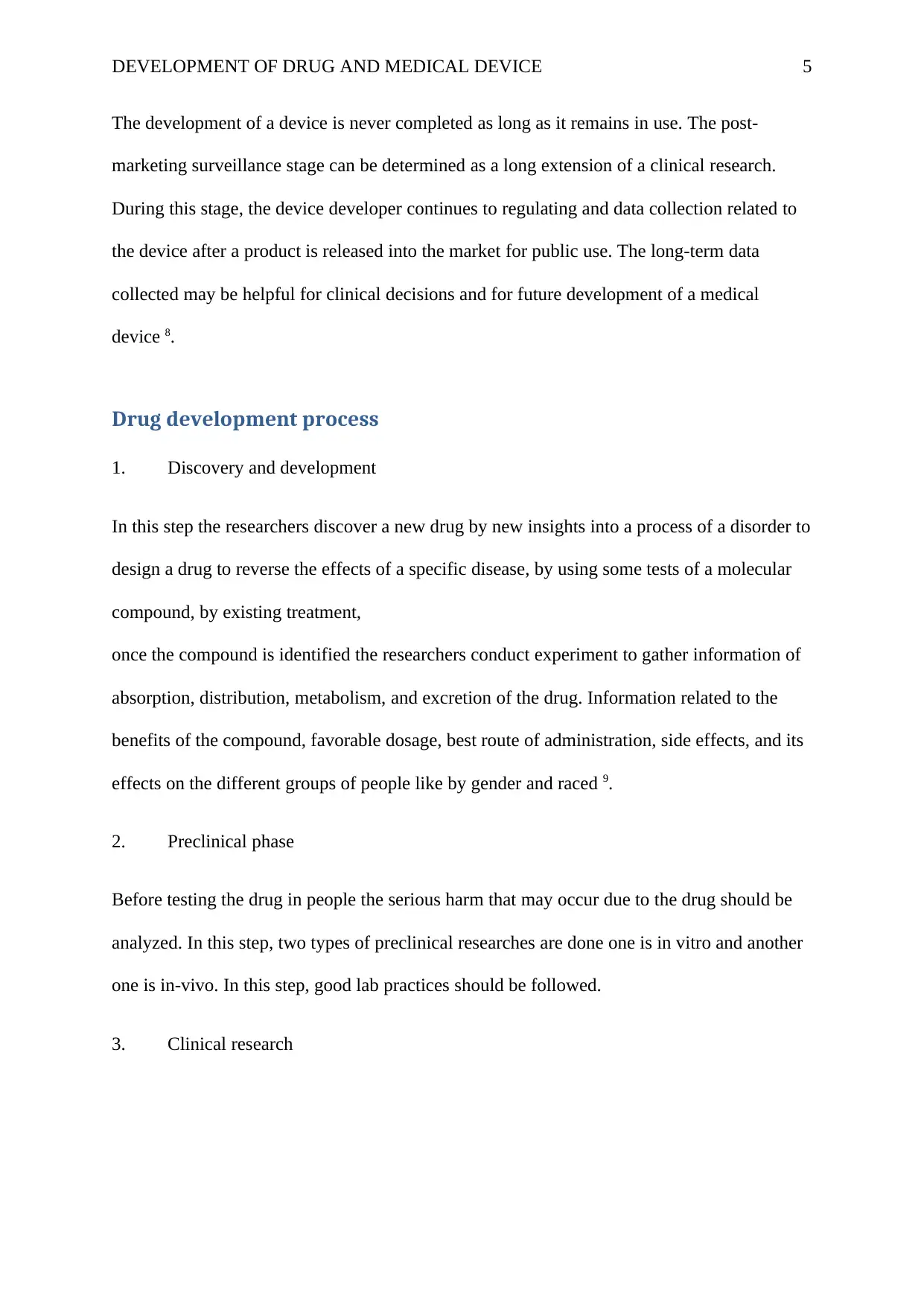
DEVELOPMENT OF DRUG AND MEDICAL DEVICE 5
The development of a device is never completed as long as it remains in use. The post-
marketing surveillance stage can be determined as a long extension of a clinical research.
During this stage, the device developer continues to regulating and data collection related to
the device after a product is released into the market for public use. The long-term data
collected may be helpful for clinical decisions and for future development of a medical
device 8.
Drug development process
1. Discovery and development
In this step the researchers discover a new drug by new insights into a process of a disorder to
design a drug to reverse the effects of a specific disease, by using some tests of a molecular
compound, by existing treatment,
once the compound is identified the researchers conduct experiment to gather information of
absorption, distribution, metabolism, and excretion of the drug. Information related to the
benefits of the compound, favorable dosage, best route of administration, side effects, and its
effects on the different groups of people like by gender and raced 9.
2. Preclinical phase
Before testing the drug in people the serious harm that may occur due to the drug should be
analyzed. In this step, two types of preclinical researches are done one is in vitro and another
one is in-vivo. In this step, good lab practices should be followed.
3. Clinical research
The development of a device is never completed as long as it remains in use. The post-
marketing surveillance stage can be determined as a long extension of a clinical research.
During this stage, the device developer continues to regulating and data collection related to
the device after a product is released into the market for public use. The long-term data
collected may be helpful for clinical decisions and for future development of a medical
device 8.
Drug development process
1. Discovery and development
In this step the researchers discover a new drug by new insights into a process of a disorder to
design a drug to reverse the effects of a specific disease, by using some tests of a molecular
compound, by existing treatment,
once the compound is identified the researchers conduct experiment to gather information of
absorption, distribution, metabolism, and excretion of the drug. Information related to the
benefits of the compound, favorable dosage, best route of administration, side effects, and its
effects on the different groups of people like by gender and raced 9.
2. Preclinical phase
Before testing the drug in people the serious harm that may occur due to the drug should be
analyzed. In this step, two types of preclinical researches are done one is in vitro and another
one is in-vivo. In this step, good lab practices should be followed.
3. Clinical research
⊘ This is a preview!⊘
Do you want full access?
Subscribe today to unlock all pages.

Trusted by 1+ million students worldwide
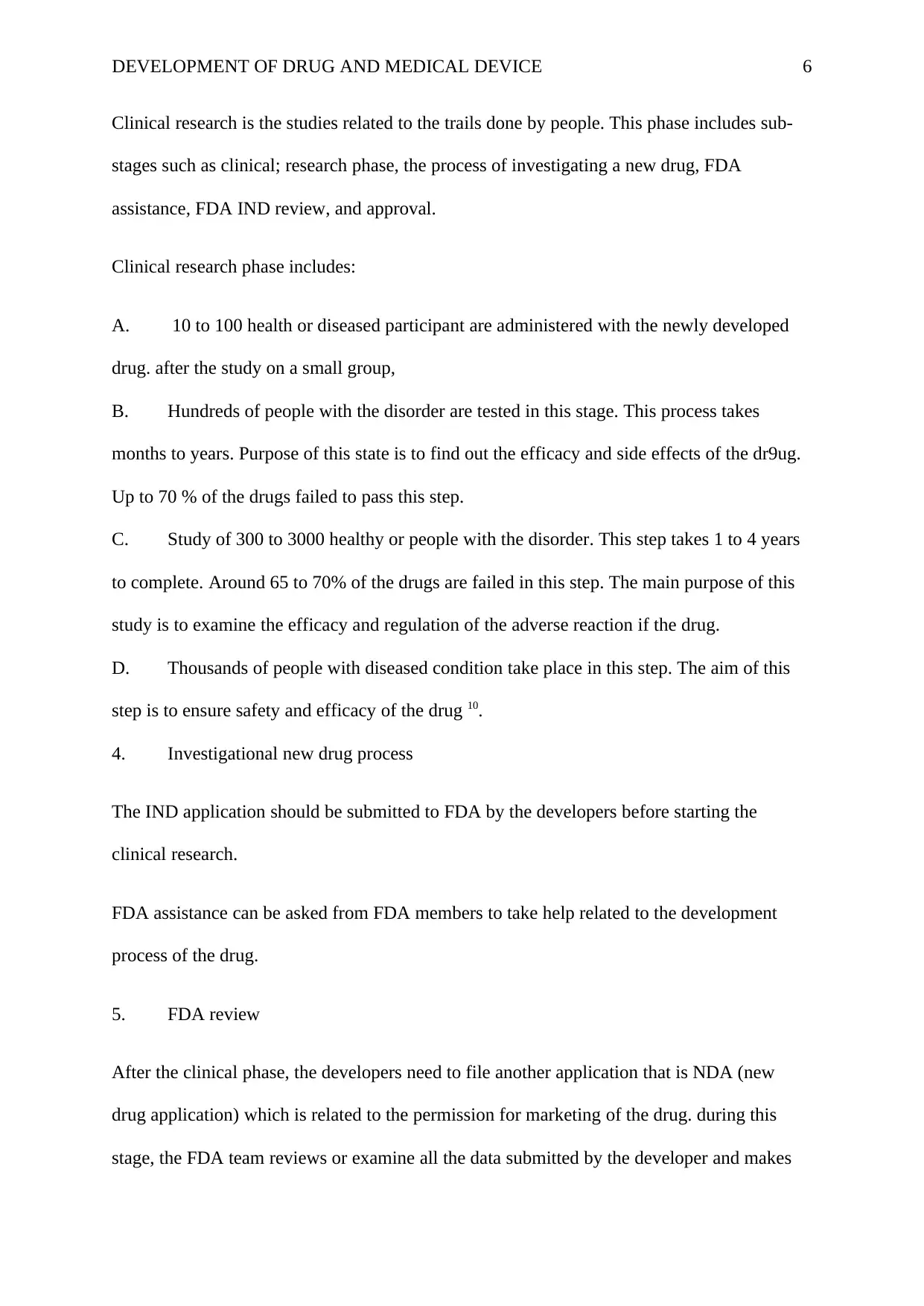
DEVELOPMENT OF DRUG AND MEDICAL DEVICE 6
Clinical research is the studies related to the trails done by people. This phase includes sub-
stages such as clinical; research phase, the process of investigating a new drug, FDA
assistance, FDA IND review, and approval.
Clinical research phase includes:
A. 10 to 100 health or diseased participant are administered with the newly developed
drug. after the study on a small group,
B. Hundreds of people with the disorder are tested in this stage. This process takes
months to years. Purpose of this state is to find out the efficacy and side effects of the dr9ug.
Up to 70 % of the drugs failed to pass this step.
C. Study of 300 to 3000 healthy or people with the disorder. This step takes 1 to 4 years
to complete. Around 65 to 70% of the drugs are failed in this step. The main purpose of this
study is to examine the efficacy and regulation of the adverse reaction if the drug.
D. Thousands of people with diseased condition take place in this step. The aim of this
step is to ensure safety and efficacy of the drug 10.
4. Investigational new drug process
The IND application should be submitted to FDA by the developers before starting the
clinical research.
FDA assistance can be asked from FDA members to take help related to the development
process of the drug.
5. FDA review
After the clinical phase, the developers need to file another application that is NDA (new
drug application) which is related to the permission for marketing of the drug. during this
stage, the FDA team reviews or examine all the data submitted by the developer and makes
Clinical research is the studies related to the trails done by people. This phase includes sub-
stages such as clinical; research phase, the process of investigating a new drug, FDA
assistance, FDA IND review, and approval.
Clinical research phase includes:
A. 10 to 100 health or diseased participant are administered with the newly developed
drug. after the study on a small group,
B. Hundreds of people with the disorder are tested in this stage. This process takes
months to years. Purpose of this state is to find out the efficacy and side effects of the dr9ug.
Up to 70 % of the drugs failed to pass this step.
C. Study of 300 to 3000 healthy or people with the disorder. This step takes 1 to 4 years
to complete. Around 65 to 70% of the drugs are failed in this step. The main purpose of this
study is to examine the efficacy and regulation of the adverse reaction if the drug.
D. Thousands of people with diseased condition take place in this step. The aim of this
step is to ensure safety and efficacy of the drug 10.
4. Investigational new drug process
The IND application should be submitted to FDA by the developers before starting the
clinical research.
FDA assistance can be asked from FDA members to take help related to the development
process of the drug.
5. FDA review
After the clinical phase, the developers need to file another application that is NDA (new
drug application) which is related to the permission for marketing of the drug. during this
stage, the FDA team reviews or examine all the data submitted by the developer and makes
Paraphrase This Document
Need a fresh take? Get an instant paraphrase of this document with our AI Paraphraser
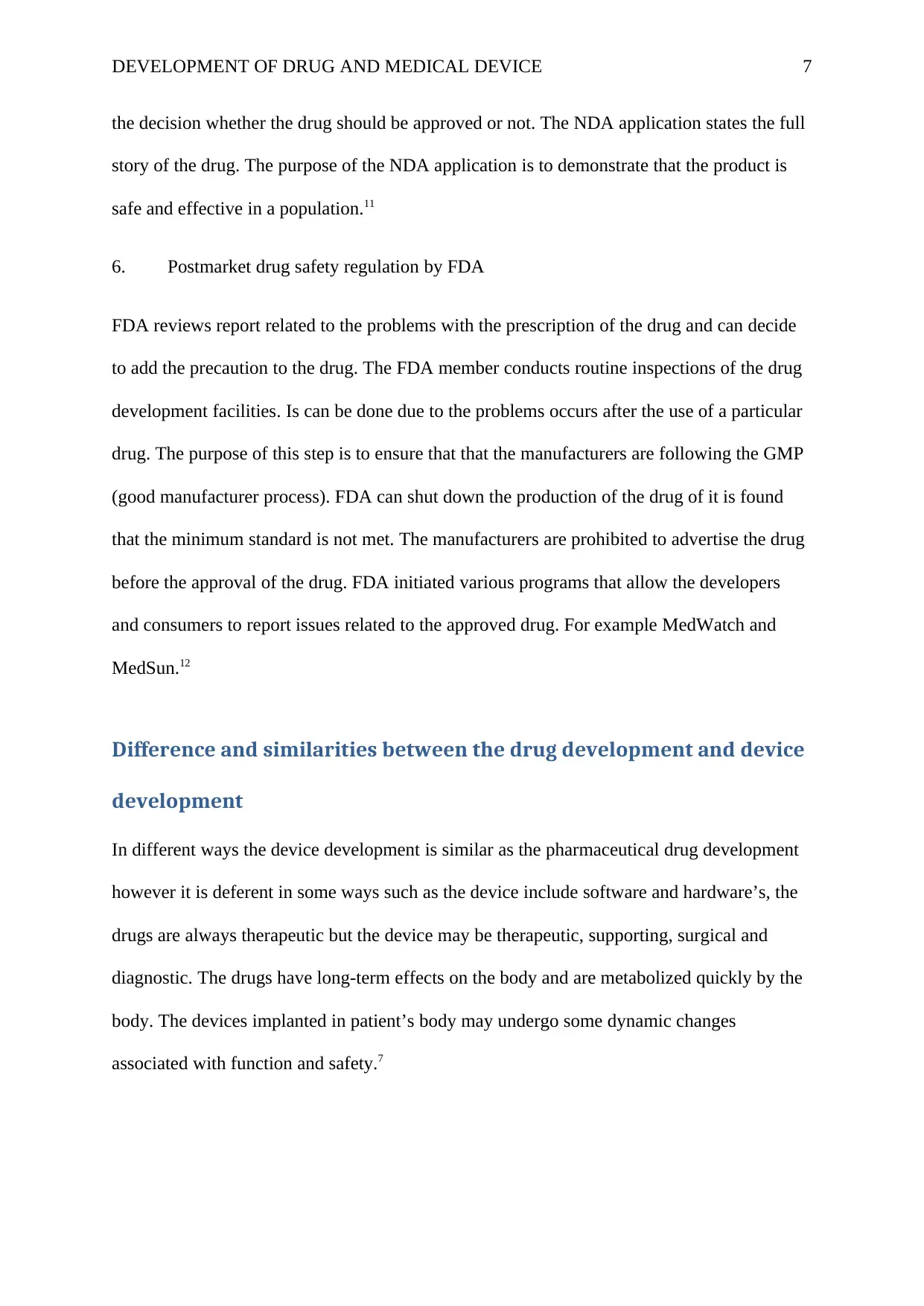
DEVELOPMENT OF DRUG AND MEDICAL DEVICE 7
the decision whether the drug should be approved or not. The NDA application states the full
story of the drug. The purpose of the NDA application is to demonstrate that the product is
safe and effective in a population.11
6. Postmarket drug safety regulation by FDA
FDA reviews report related to the problems with the prescription of the drug and can decide
to add the precaution to the drug. The FDA member conducts routine inspections of the drug
development facilities. Is can be done due to the problems occurs after the use of a particular
drug. The purpose of this step is to ensure that that the manufacturers are following the GMP
(good manufacturer process). FDA can shut down the production of the drug of it is found
that the minimum standard is not met. The manufacturers are prohibited to advertise the drug
before the approval of the drug. FDA initiated various programs that allow the developers
and consumers to report issues related to the approved drug. For example MedWatch and
MedSun.12
Difference and similarities between the drug development and device
development
In different ways the device development is similar as the pharmaceutical drug development
however it is deferent in some ways such as the device include software and hardware’s, the
drugs are always therapeutic but the device may be therapeutic, supporting, surgical and
diagnostic. The drugs have long-term effects on the body and are metabolized quickly by the
body. The devices implanted in patient’s body may undergo some dynamic changes
associated with function and safety.7
the decision whether the drug should be approved or not. The NDA application states the full
story of the drug. The purpose of the NDA application is to demonstrate that the product is
safe and effective in a population.11
6. Postmarket drug safety regulation by FDA
FDA reviews report related to the problems with the prescription of the drug and can decide
to add the precaution to the drug. The FDA member conducts routine inspections of the drug
development facilities. Is can be done due to the problems occurs after the use of a particular
drug. The purpose of this step is to ensure that that the manufacturers are following the GMP
(good manufacturer process). FDA can shut down the production of the drug of it is found
that the minimum standard is not met. The manufacturers are prohibited to advertise the drug
before the approval of the drug. FDA initiated various programs that allow the developers
and consumers to report issues related to the approved drug. For example MedWatch and
MedSun.12
Difference and similarities between the drug development and device
development
In different ways the device development is similar as the pharmaceutical drug development
however it is deferent in some ways such as the device include software and hardware’s, the
drugs are always therapeutic but the device may be therapeutic, supporting, surgical and
diagnostic. The drugs have long-term effects on the body and are metabolized quickly by the
body. The devices implanted in patient’s body may undergo some dynamic changes
associated with function and safety.7
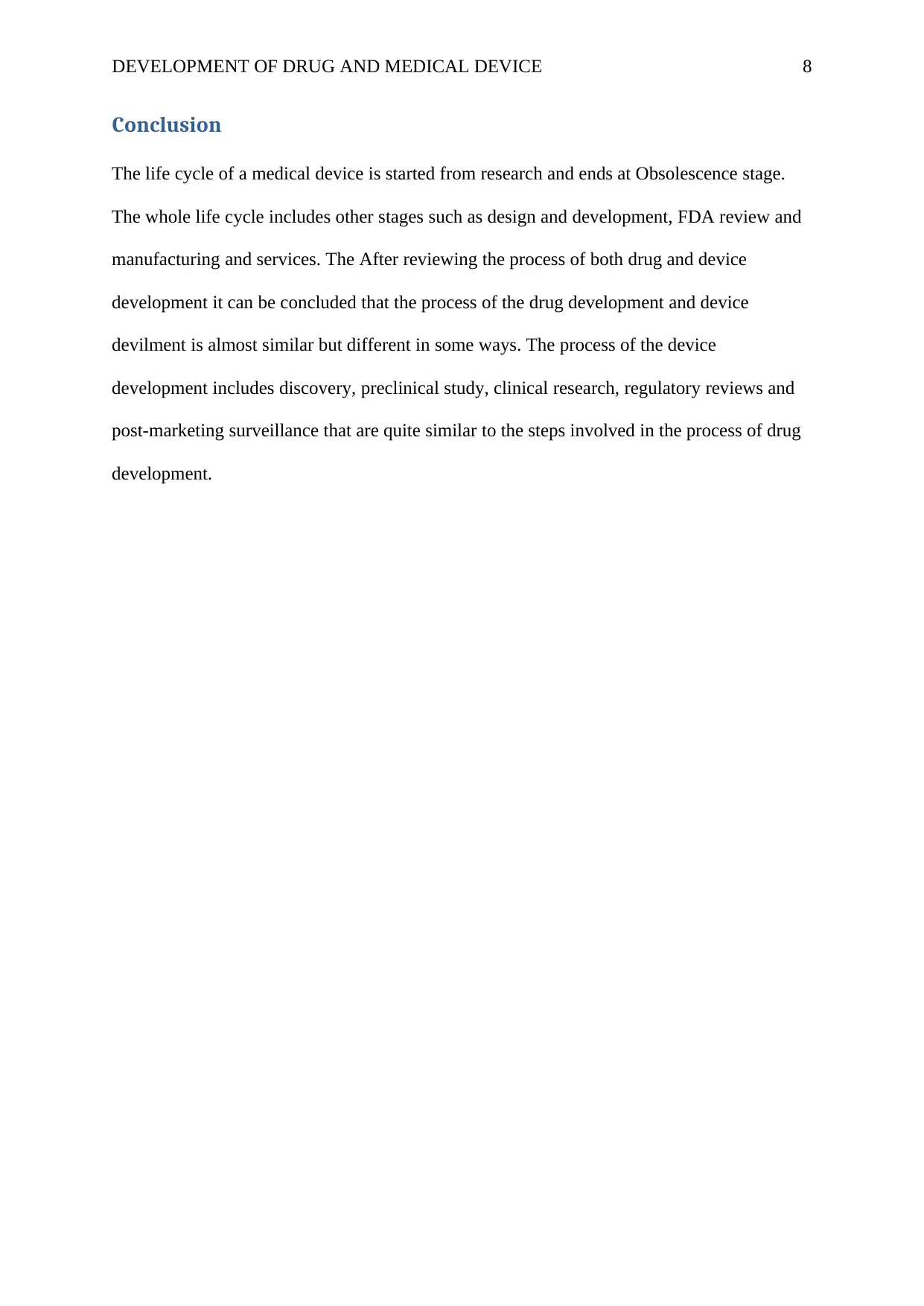
DEVELOPMENT OF DRUG AND MEDICAL DEVICE 8
Conclusion
The life cycle of a medical device is started from research and ends at Obsolescence stage.
The whole life cycle includes other stages such as design and development, FDA review and
manufacturing and services. The After reviewing the process of both drug and device
development it can be concluded that the process of the drug development and device
devilment is almost similar but different in some ways. The process of the device
development includes discovery, preclinical study, clinical research, regulatory reviews and
post-marketing surveillance that are quite similar to the steps involved in the process of drug
development.
Conclusion
The life cycle of a medical device is started from research and ends at Obsolescence stage.
The whole life cycle includes other stages such as design and development, FDA review and
manufacturing and services. The After reviewing the process of both drug and device
development it can be concluded that the process of the drug development and device
devilment is almost similar but different in some ways. The process of the device
development includes discovery, preclinical study, clinical research, regulatory reviews and
post-marketing surveillance that are quite similar to the steps involved in the process of drug
development.
⊘ This is a preview!⊘
Do you want full access?
Subscribe today to unlock all pages.

Trusted by 1+ million students worldwide
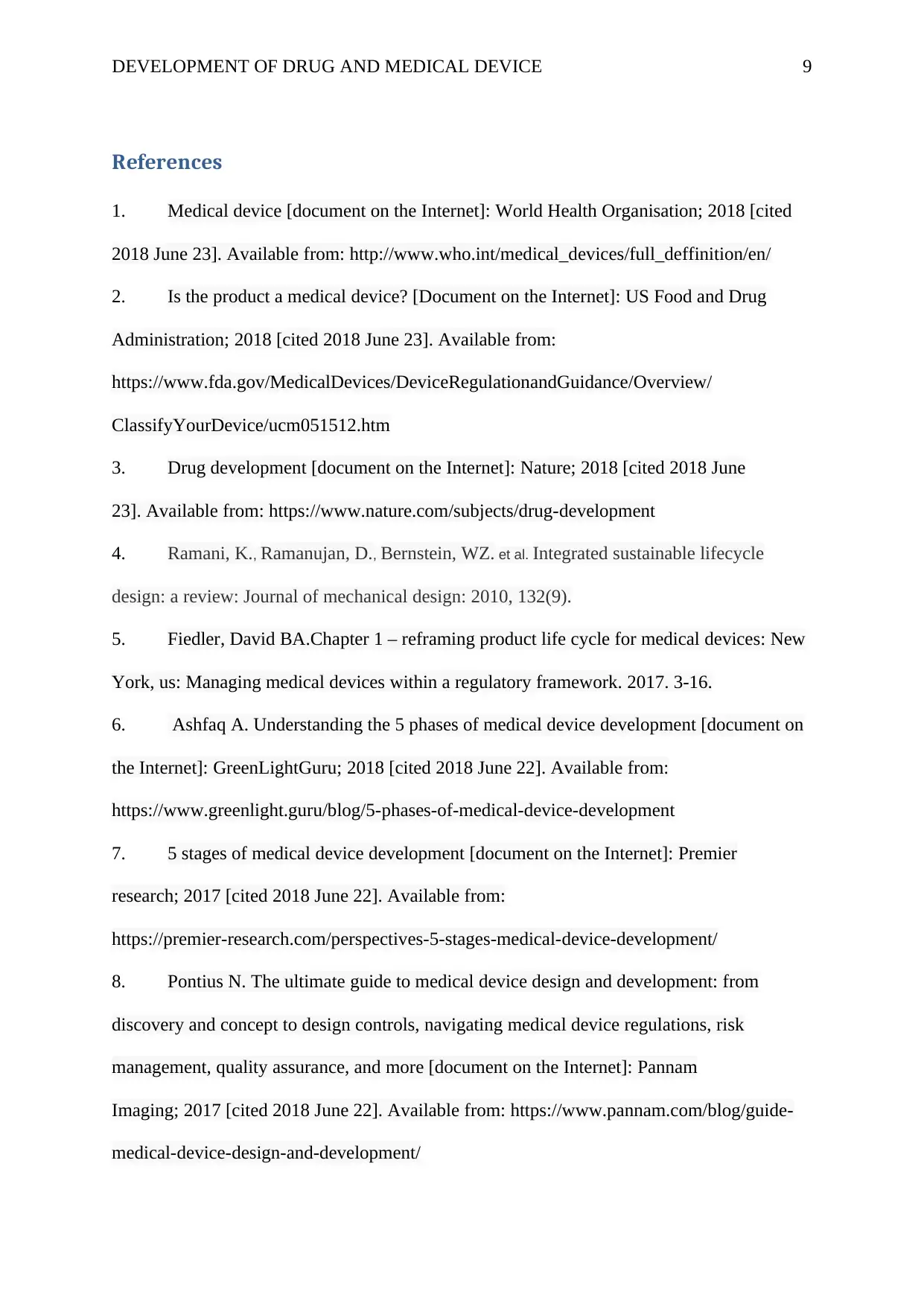
DEVELOPMENT OF DRUG AND MEDICAL DEVICE 9
References
1. Medical device [document on the Internet]: World Health Organisation; 2018 [cited
2018 June 23]. Available from: http://www.who.int/medical_devices/full_deffinition/en/
2. Is the product a medical device? [Document on the Internet]: US Food and Drug
Administration; 2018 [cited 2018 June 23]. Available from:
https://www.fda.gov/MedicalDevices/DeviceRegulationandGuidance/Overview/
ClassifyYourDevice/ucm051512.htm
3. Drug development [document on the Internet]: Nature; 2018 [cited 2018 June
23]. Available from: https://www.nature.com/subjects/drug-development
4. Ramani, K., Ramanujan, D., Bernstein, WZ. et al. Integrated sustainable lifecycle
design: a review: Journal of mechanical design: 2010, 132(9).
5. Fiedler, David BA.Chapter 1 – reframing product life cycle for medical devices: New
York, us: Managing medical devices within a regulatory framework. 2017. 3-16.
6. Ashfaq A. Understanding the 5 phases of medical device development [document on
the Internet]: GreenLightGuru; 2018 [cited 2018 June 22]. Available from:
https://www.greenlight.guru/blog/5-phases-of-medical-device-development
7. 5 stages of medical device development [document on the Internet]: Premier
research; 2017 [cited 2018 June 22]. Available from:
https://premier-research.com/perspectives-5-stages-medical-device-development/
8. Pontius N. The ultimate guide to medical device design and development: from
discovery and concept to design controls, navigating medical device regulations, risk
management, quality assurance, and more [document on the Internet]: Pannam
Imaging; 2017 [cited 2018 June 22]. Available from: https://www.pannam.com/blog/guide-
medical-device-design-and-development/
References
1. Medical device [document on the Internet]: World Health Organisation; 2018 [cited
2018 June 23]. Available from: http://www.who.int/medical_devices/full_deffinition/en/
2. Is the product a medical device? [Document on the Internet]: US Food and Drug
Administration; 2018 [cited 2018 June 23]. Available from:
https://www.fda.gov/MedicalDevices/DeviceRegulationandGuidance/Overview/
ClassifyYourDevice/ucm051512.htm
3. Drug development [document on the Internet]: Nature; 2018 [cited 2018 June
23]. Available from: https://www.nature.com/subjects/drug-development
4. Ramani, K., Ramanujan, D., Bernstein, WZ. et al. Integrated sustainable lifecycle
design: a review: Journal of mechanical design: 2010, 132(9).
5. Fiedler, David BA.Chapter 1 – reframing product life cycle for medical devices: New
York, us: Managing medical devices within a regulatory framework. 2017. 3-16.
6. Ashfaq A. Understanding the 5 phases of medical device development [document on
the Internet]: GreenLightGuru; 2018 [cited 2018 June 22]. Available from:
https://www.greenlight.guru/blog/5-phases-of-medical-device-development
7. 5 stages of medical device development [document on the Internet]: Premier
research; 2017 [cited 2018 June 22]. Available from:
https://premier-research.com/perspectives-5-stages-medical-device-development/
8. Pontius N. The ultimate guide to medical device design and development: from
discovery and concept to design controls, navigating medical device regulations, risk
management, quality assurance, and more [document on the Internet]: Pannam
Imaging; 2017 [cited 2018 June 22]. Available from: https://www.pannam.com/blog/guide-
medical-device-design-and-development/
Paraphrase This Document
Need a fresh take? Get an instant paraphrase of this document with our AI Paraphraser
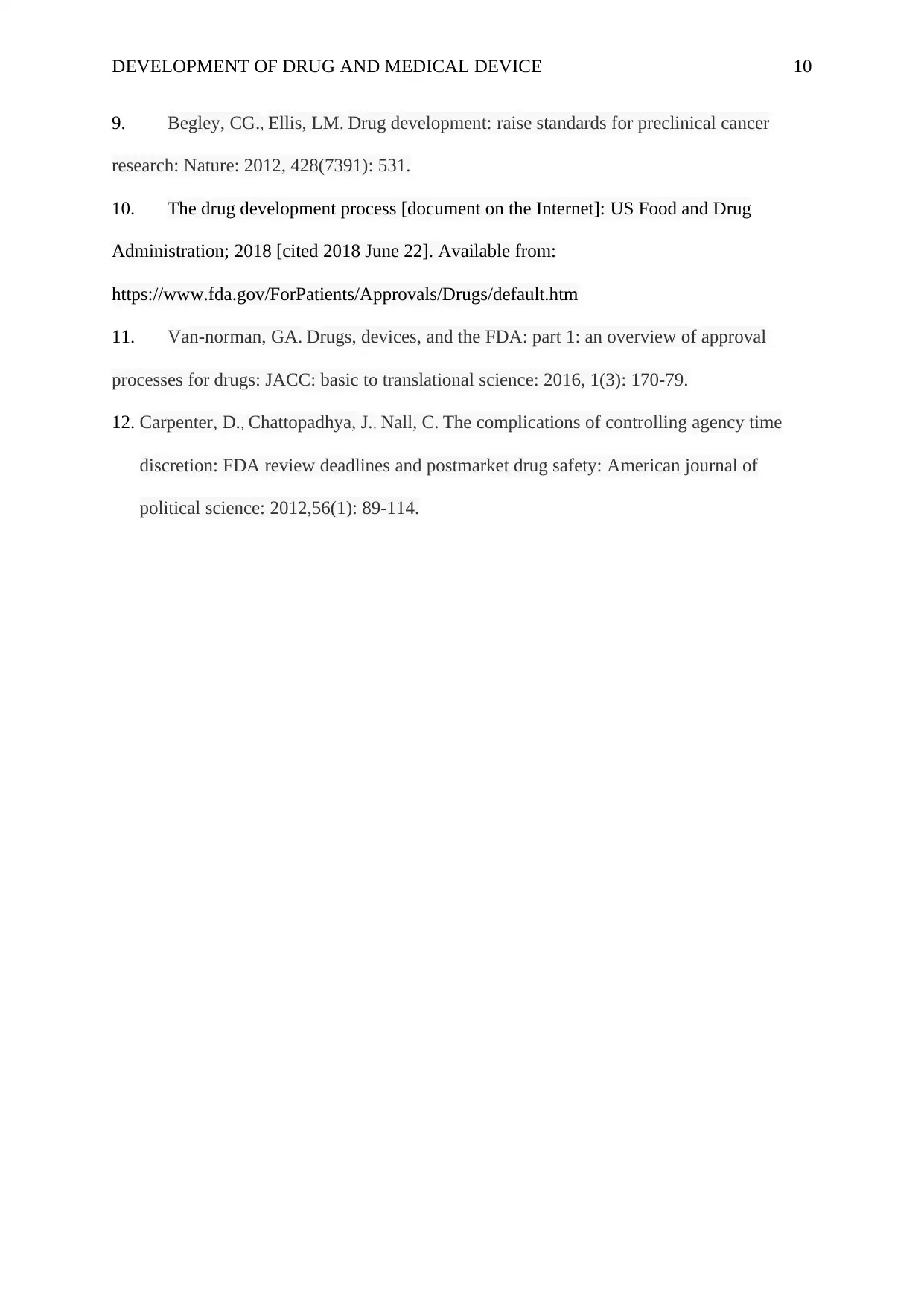
DEVELOPMENT OF DRUG AND MEDICAL DEVICE 10
9. Begley, CG., Ellis, LM. Drug development: raise standards for preclinical cancer
research: Nature: 2012, 428(7391): 531.
10. The drug development process [document on the Internet]: US Food and Drug
Administration; 2018 [cited 2018 June 22]. Available from:
https://www.fda.gov/ForPatients/Approvals/Drugs/default.htm
11. Van-norman, GA. Drugs, devices, and the FDA: part 1: an overview of approval
processes for drugs: JACC: basic to translational science: 2016, 1(3): 170-79.
12. Carpenter, D., Chattopadhya, J., Nall, C. The complications of controlling agency time
discretion: FDA review deadlines and postmarket drug safety: American journal of
political science: 2012,56(1): 89-114.
9. Begley, CG., Ellis, LM. Drug development: raise standards for preclinical cancer
research: Nature: 2012, 428(7391): 531.
10. The drug development process [document on the Internet]: US Food and Drug
Administration; 2018 [cited 2018 June 22]. Available from:
https://www.fda.gov/ForPatients/Approvals/Drugs/default.htm
11. Van-norman, GA. Drugs, devices, and the FDA: part 1: an overview of approval
processes for drugs: JACC: basic to translational science: 2016, 1(3): 170-79.
12. Carpenter, D., Chattopadhya, J., Nall, C. The complications of controlling agency time
discretion: FDA review deadlines and postmarket drug safety: American journal of
political science: 2012,56(1): 89-114.
1 out of 11
Related Documents
Your All-in-One AI-Powered Toolkit for Academic Success.
+13062052269
info@desklib.com
Available 24*7 on WhatsApp / Email
![[object Object]](/_next/static/media/star-bottom.7253800d.svg)
Unlock your academic potential
Copyright © 2020–2025 A2Z Services. All Rights Reserved. Developed and managed by ZUCOL.





